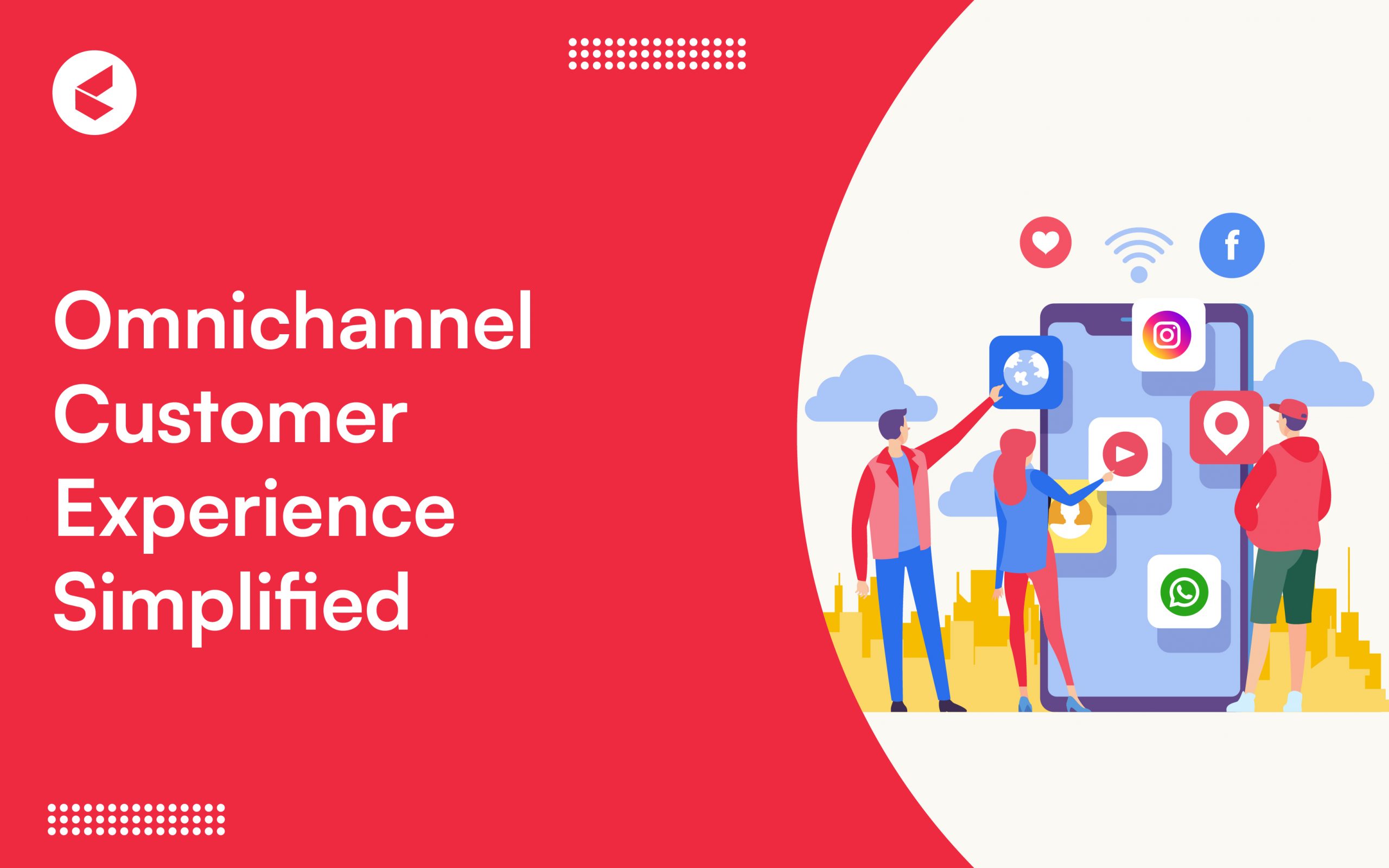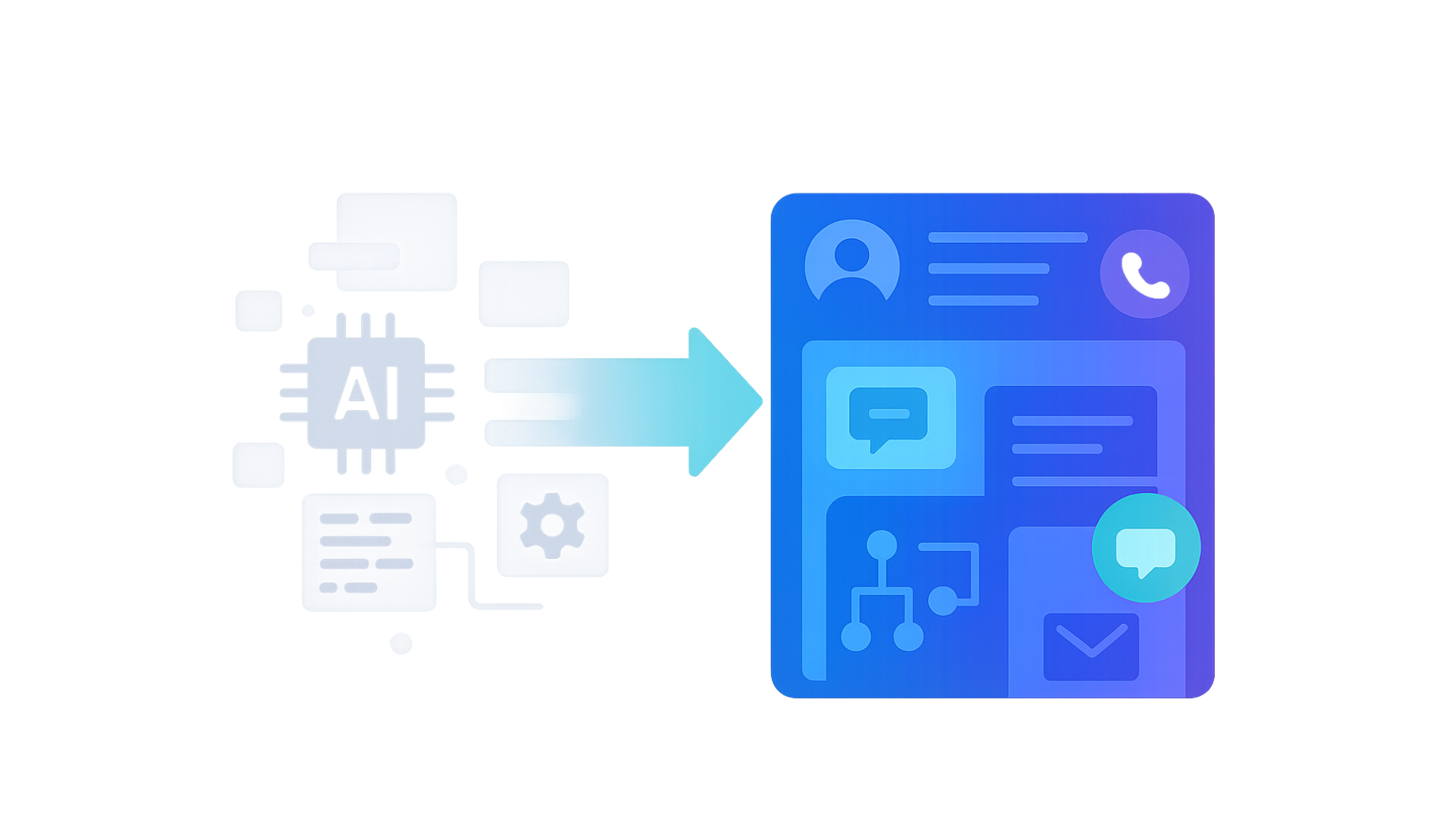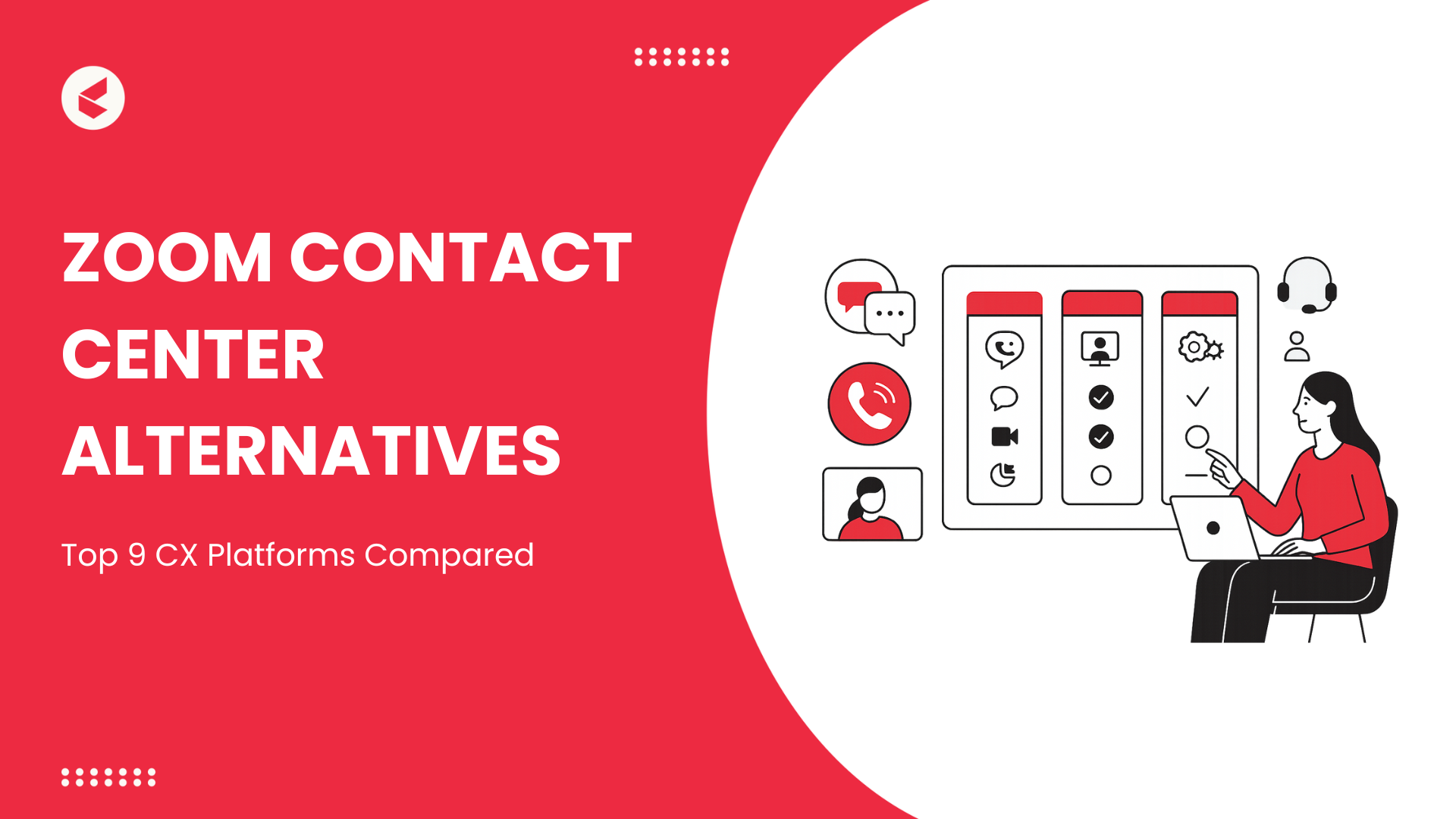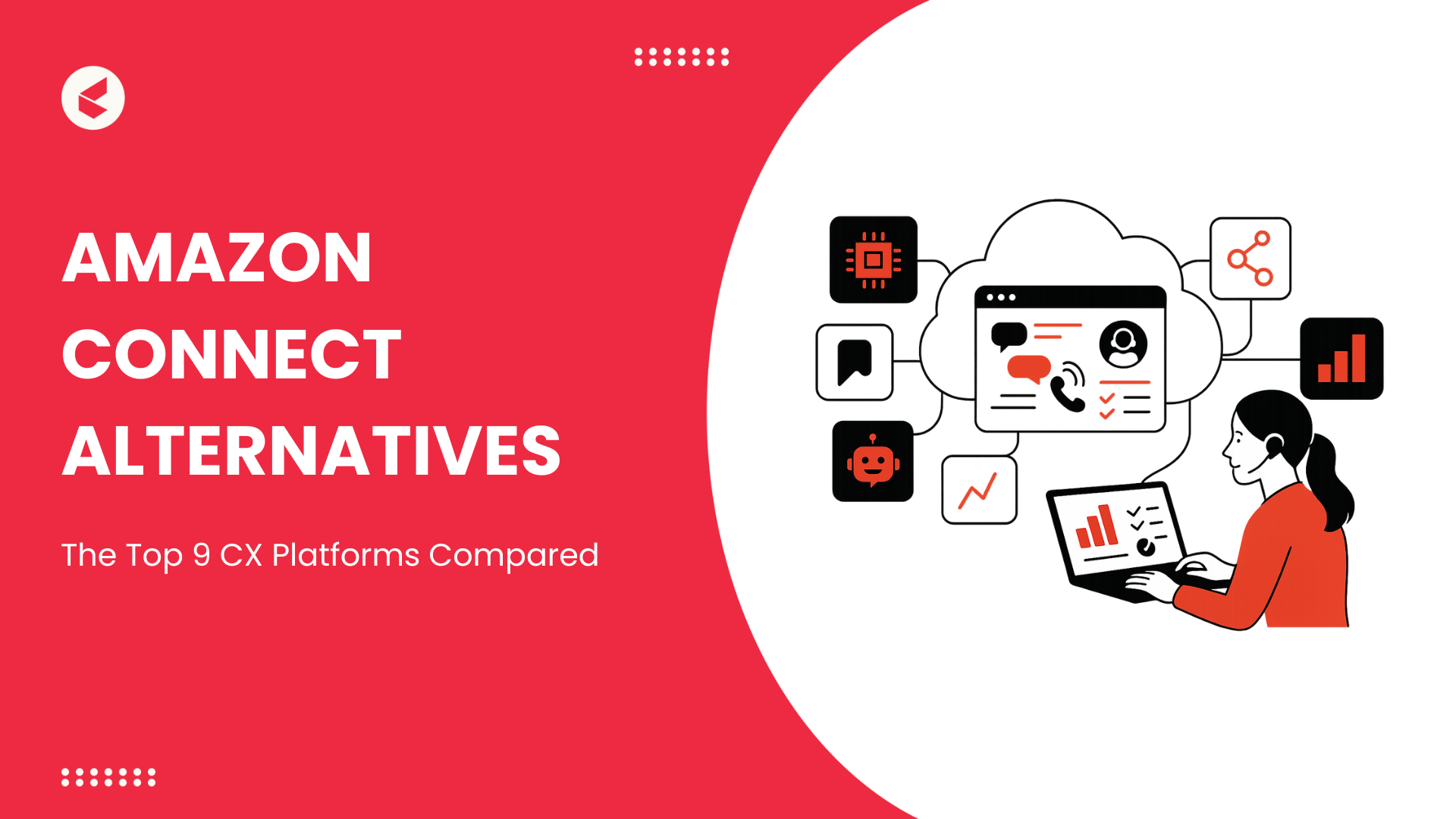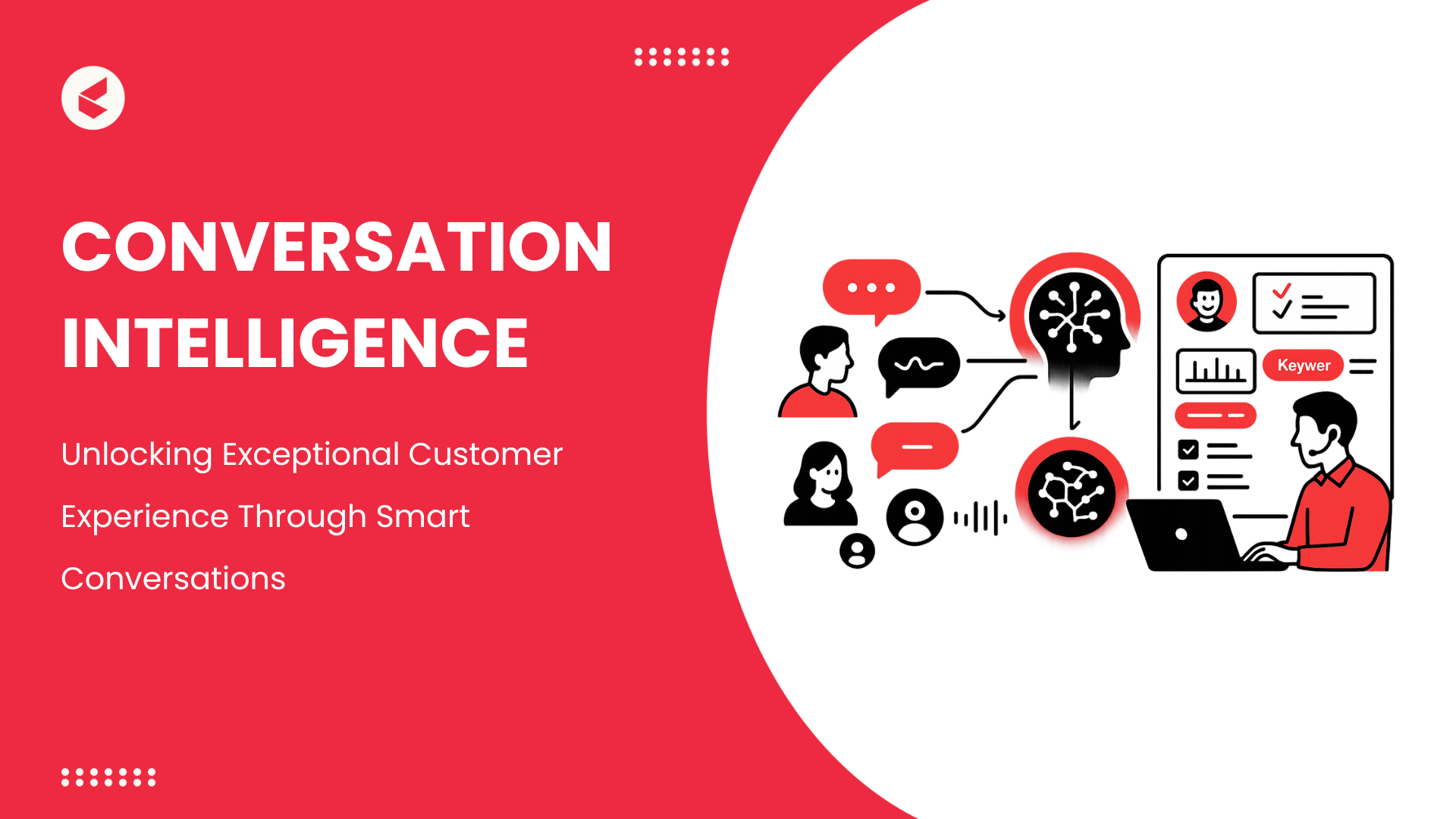Undeniably, every sector and marketplace is highly effective in contemporary society. The only difference between a business and a market is that it has to provide great customer experiences.
Numerous studies highlight the critical importance of customer experience: 73% of companies that outperform their competitors in customer experience report stronger financial results. In comparison, 96% of customers agree that exceptional customer service is key to fostering brand loyalty.
In order to live up to such high expectations, it is recommended that firms implement an omnichannel customer service approach. This approach centers a number of channels, be it chat, social media, emails, phone calls or face-to-face engagements, in a way that makes all interactions feel integrated and tailored.
In this article, we will explore the meaning of an omnichannel contact center, its advantages for a brand, and the most effective methods for tackling its everyday operational problems. Let’s get started!
What Is an Omnichannel Contact Center?
In the digital era, customers no longer rely on a single platform. Instead, they usually connect with brands using multiple channels, making it important for brands to be present on each platform.
According to Statista, 94% of consumers are likely to buy from a company again after a good service experience, and 82% would endorse the organization based on their opinion purely on the customer service.
Although traditional communication methods like email and phone remain popular and are often complemented by in-person meetings, each channel contributes positively to the business. This highlights the value of providing an omnichannel customer experience, where all communication channels are integrated for seamless support.
Omnichannel systems guarantee that all channel interactions are connected, unlike traditional or multichannel configurations, in which each channel functions separately.
For instance, if a customer initiates a conversation via live chat and later follows up using a phone call, they do not have to repeat the issue. An omnichannel approach ensures that the customer support staff has all the information about the customer, providing a smooth, uninterrupted customer experience.
This also significantly benefits your contact centers. The omnichannel contact center combines all customer interactions into one dashboard, giving the service teams the history of all the touchpoints for a client, improving their support, and making it faster and smarter.
Multichannel vs. Omnichannel Solutions
Both multichannel and omnichannel solutions allow for cross-platform communication, yet omnichannel contact centers offer an integrated customer-focused experience that multichannel systems are incapable of offering.
For instance, in a multichannel contact center, a customer can email and live chat with an agent but can’t move between these channels without having to start all over again.
Conversely, an omnichannel contact center interconnects all transport networks, allowing customers to access their emails, chats, and voice call histories effortlessly, creating a rich customer experience where every individual is treated uniquely.
Here’s a table highlighting the key differences between their features:
| Feature | Multichannel Contact Center | Omnichannel Contact Center |
| Information consistency | Customers have to repeat the same information when switching between channels or departments. | Customers do not have to repeat the same information as the agent gets the complete context of previous interactions. |
| Interaction history | Multichannel solutions cannot give an agent a full view of all previous interactions, as they operate in silos. | Omnichannel solutions give agents a complete view of all channel customer interactions since they use a unified system. |
| Customer experience | Customer experience may differ on each channel, as they operate separately. | Ensures consistent customer experience across all channels. |
| Customer frustration | Since the customers have to reiterate their problems and complaints to the agents, it frustrates them. | Since the agent has all the context regardless of the platform, customers have a more personalized and efficient interaction, which increases customer satisfaction and loyalty. |
| Strategic focus | The multi-channel strategy focuses on being present on several channels, where channel presence becomes an important success factor. | An omnichannel approach aims to integrate all platforms seamlessly, thereby emphasizing customer experience as the key success factor. |
Benefits of Omnichannel Contact Centers for Businesses
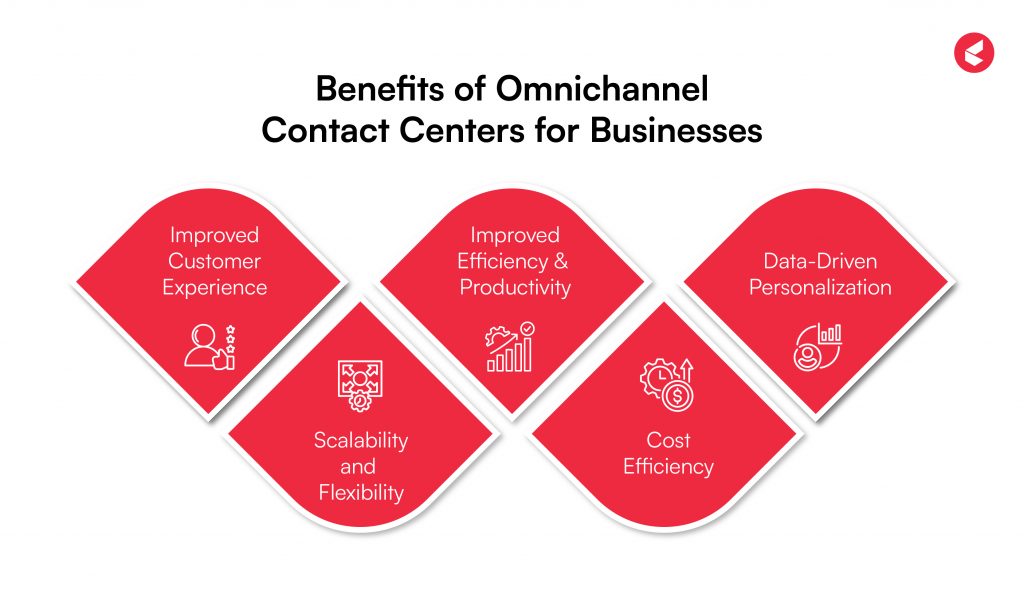
By implementing an omnichannel contact center approach, businesses of all sizes can get several key advantages, such as:
1. Improved Customer Experience
At the heart of omnichannel contact centers is continuity, which means an uninterrupted customer journey.
Customers often switch platforms depending on personal preference and the complexity of the issue. Since all their data is stored on a unified platform, all the interactions are available to agents no matter the channel used. This smooth experience leads to increased satisfaction rates and less client annoyance.
2. Improved Efficiency & Productivity
Omnichannel contact center software helps businesses integrate and put all the customer interactions within one interface, giving agents 360° visibility. This visibility ensures that agents do not have to scramble for information or ask the customer to repeat their issue.
It lets the agent address those concerns quickly and efficiently, ensuring faster response times and improved productivity.
3. Data-Driven Personalization
In a 2022 survey of corporate leaders, 35% indicated success with omnichannel personalization, up from 24% the previous year. This is because an omnichannel contact center combines customer information from multiple channels, which can be used to gain insights into customer behavior, preferences, and pain points.
This data can be used to provide a more personalized experience, such as engaging customers on their preferred channels or anticipating future interactions with the organization.
An omnichannel contact center platform also provides incredibly thorough data and analytics, allowing for ongoing development in the customer support process.
4. Scalability and Flexibility
As the business grows, the need for customer service increases. An omnichannel contact center platform is scalable and makes it easy to add new communications channels or feature upgrades as and when needed.
This flexibility allows the system to evolve through changing customer expectations and business goals without putting a huge strain on your overall costs. Omnichannel contact center platforms may accommodate growth in new markets or provide new services without affecting the latest customer experience.
5. Cost Efficiency
By implementing an omnichannel contact center, you can gain long-term benefits and cost savings.
As operations become more streamlined, the company’s operational cost decreases. This will also improve agent efficiency, which in turn will improve customer retention.
By unifying the customer information, agents can get full information about a customer’s issue and have a better chance of resolving it. This helps minimize the chances of escalations.
Thus, using an omnichannel contact center results in two wins:
- Customer support costs are reduced
- Customers are happy, leading to recurring revenue and more business
This makes an omnichannel approach a win-win for your customers and your brand.
Common Challenges in Implementing an Omnichannel Strategy
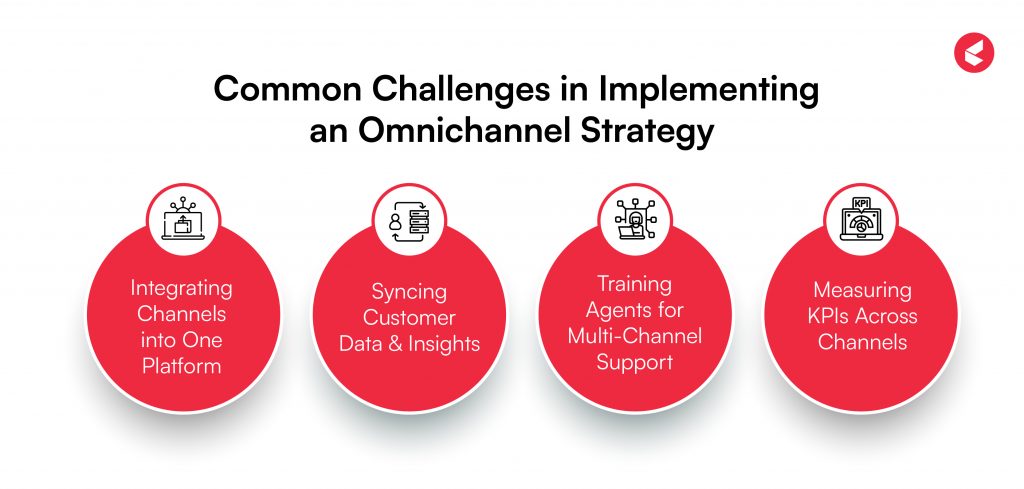
Although omnichannel contact centers have numerous benefits, they are not foolproof. Yes, challenges do exist, but strategies can help address these common issues.
Below are some of the most common obstacles and how businesses can address them:
1. Integrating All Your Channels and Communication in One Platform
The most common challenge for businesses is to gather data from multiple channels into an integrated solution. Since each channel uses a separate platform to store information and manage communication, combining this data into one solution becomes a tedious task.
The Solution: Opt for a strong omnichannel platform that enables seamless channel integration and offers a real-time 360-degree view of customer data. Make sure that it has built-in integrations or syncs with your chosen communication channels, enabling a comprehensive customer view.
2. Syncing Customer Data and Insights
With omnichannel contact centers, vast amounts of data are generated across multiple touchpoints.
Managing and synchronizing such information in real time is often a pain point. It could also lead to duplicate or inconsistent customer records, which could lead to response delays or incorrect insights.
The Solution: To have a centralized customer database that syncs all customer data. Businesses should ensure that their omnichannel platform provides strong capabilities for data management, such as real-time updates and automatic data syncing from different sources. Centralizing this information help solve the data management issues, such as preventing data duplication and improving real-time insights.
3. Training Agents to Handle Multiple Communication Channels
Agents who are used to handling only one or two communication channels may find it overwhelming to manage customer interactions across various platforms. This may lead to poor service delivery and slower reaction time since the agent is not used to dealing with customer interactions on multiple channels.
The Solution: Businesses must invest in the right training programs to arm agents with the skills needed to handle omnichannel communication. This includes familiarizing them with the technology, teaching them how to transition between channels seamlessly, and providing best practices for delivering consistent customer service.
It should not be a one-time activity but an ongoing process, allowing agents to be upskilled and trained to become effective over time.
4. Measuring Key Performance Indicator (KPI) for Each Channel
Often, the major hurdle in implementing a successful omnichannel strategy is measuring the return on investment and defining the KPI for every channel.
For instance, if the key performance indicator is not well defined, a business will face difficulty in determining how far its omnichannel strategy is taking its business benefits.
The Solution: Define unique KPIs for each communication channel and use them to determine overall success. When assessing the performance of the omnichannel contact center, always consider tracking basic KPIs like median time to resolution, customer feedback scores, and first contact resolution rates.
Key Features to Look for in Omnichannel Contact Center Software
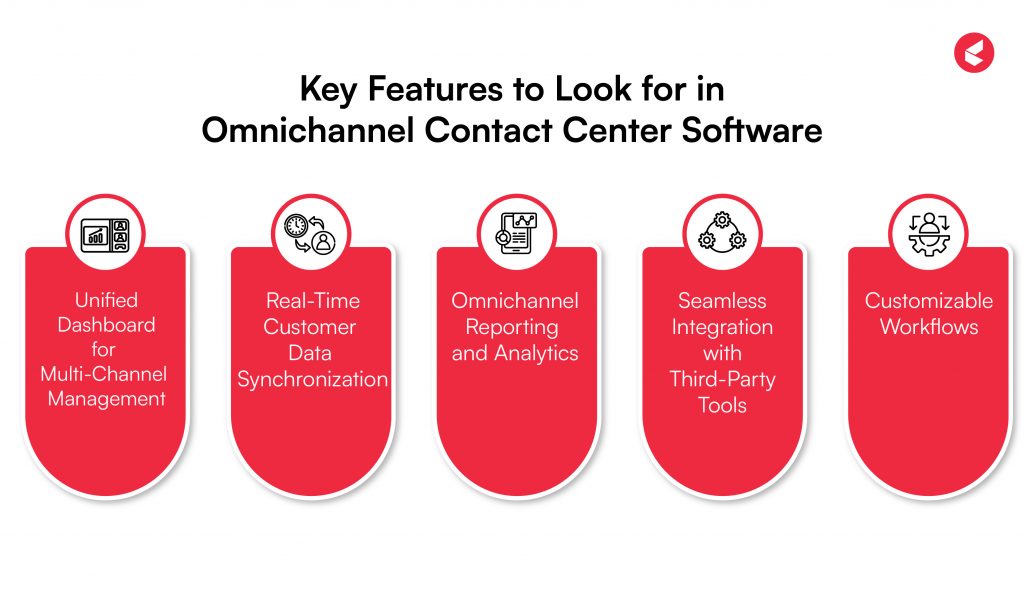
With the right solution, you should be able to increase your agents’ productivity while providing a smooth and consistent experience across all communication channels.
So, you should pick an omnichannel contact center software with the following features:
1. Unified Dashboard for Multi-Channel Management
A unified dashboard allows agents to manage all their interactions much more efficiently without having to log in and out of several different tools or interfaces. Therefore, the wait time is reduced, and customers get a more streamlined experience, no matter which platform they are on.
2. Real-Time Customer Data Synchronization
By utilizing real-time customer data, support agents get the latest details on a customer issue. This allows them to provide contextualized and personalized experiences, picking up from the previous interaction for greater clarity.
3. Omnichannel Reporting and Analytics
Customer satisfaction (CSAT) ratings, average resolution time, first-response time, and channel-specific performance are just a few of the important indicators for which the program should provide customized reports. By analyzing these metrics, businesses can determine their strengths and areas for development.
Tracking agent productivity, customer interactions, and response times helps refine customer service strategies and ensures continuous optimization.
4. Seamless Integration with Third-Party Tools
Your omnichannel contact center software should integrate seamlessly with existing CX systems, help desk tools, and other third-party applications that your business relies on. This ensures all systems are aligned, making customer data accessible across platforms.
5. Customizable Workflows
Every organization has a process to deal with customer issues and inquiries. Using an omnichannel solution, these workflows can be integrated into the platform so that companies can continue their existing process without needing to make too many adjustments.
Best Practices and Strategies for Omnichannel Success
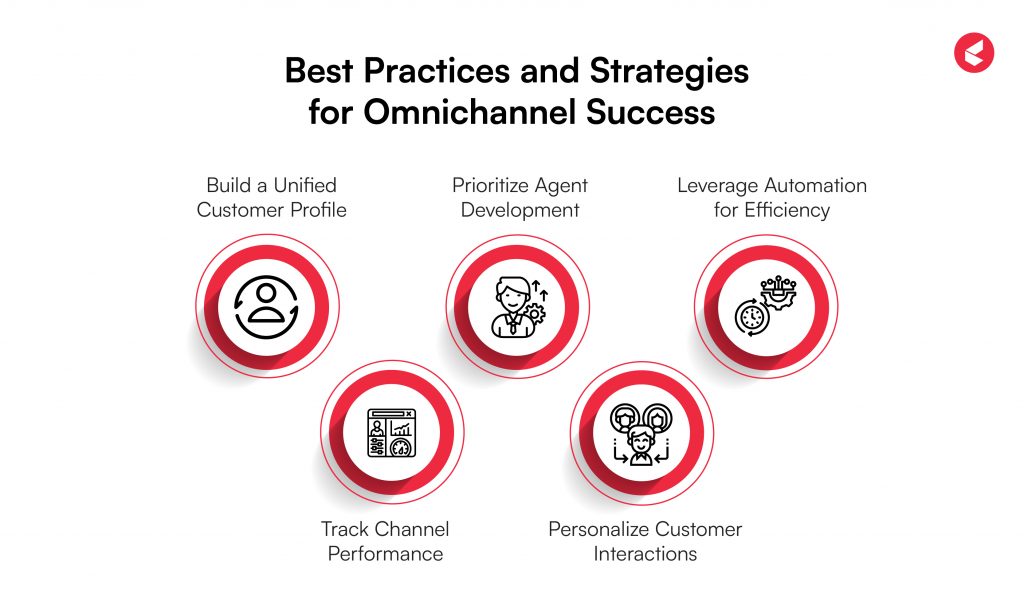
Although picking the best omnichannel contact center software is the first step towards improved customer experiences, it alone cannot guarantee success.
Use these tried-and-tested tactics to be successful in omnichannel customer service:
1. Create a Unified Customer Profile
An omnichannel strategy can succeed only when agents have an end-to-end view of the customer’s interactions and details. This entails combining every touchpoint into a single, all-inclusive client profile that is instantly accessible.
2. Attention to Agent Development Comes First
When there are no adequately trained personnel, no matter how good the omnichannel software is, it will not bear any fruit. Customer care agents should have an understanding of the different channels, as well as the processes and systems that ensure that the omnichannel approach is a success.
3. Utilize Automation to Boost Productivity
Contact center automation plays a significant role in the effectiveness of the omnichannel contact center. Basic queries can be taken care of by a chatbot or an AI-enabled workflow with auto-responses to enable human agents to focus on assisting clients with more complex issues.
4. Monitor and Measure Channel Performance
Businesses must constantly assess their contact center’s performance across all channels to guarantee success. Any communication platform entails monitoring metrics such as response time, customer satisfaction (CSAT) ratings, and first-contact resolution (FCR).
5. Personalize Customer Interactions
In an omnichannel environment, enhancing customer satisfaction hinges on personalization. Agents can interact with a customer’s data in such a way that individual preferences and requirements are met, making the customer feel appreciated and understood.
Training Your Agents for Omnichannel Success
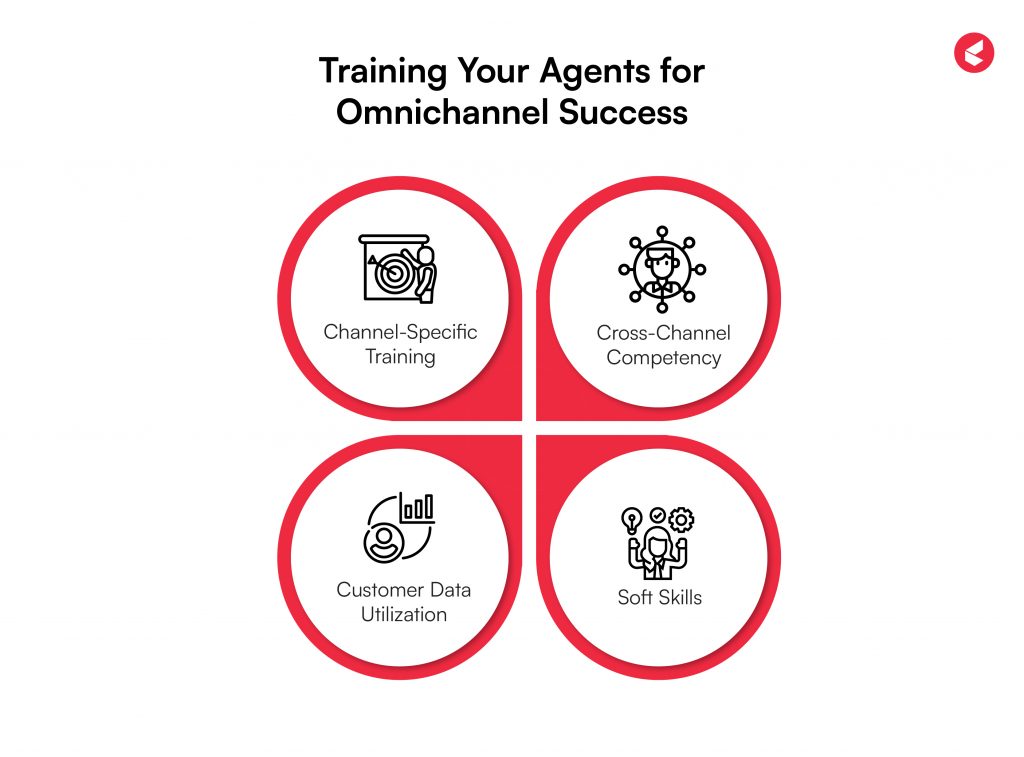
No matter how powerful your omnichannel contact center software is, it will lead to technical challenges and even reduce productivity if your teams cannot leverage it properly.
To make the best of an omnichannel contact center strategy, provide adequate training to your staff. The training should focus on technical and soft skills to ensure that agents can handle inquiries professionally and efficiently, regardless of the channel they are on.
For this, you will need to focus your training on aspects like:
1. Channel-Specific Training
Provide training to your agents on handling inquiries differently based on whether they are engaging with customers through live chat, email, phone, or social media. For example, chat and social media interactions require quicker, more concise responses, while phone calls may require a more empathetic, conversational approach.
2. Cross-Channel Competency
While agents may specialize in one or two channels, they should be cross-trained to handle interactions on multiple platforms.
So, create a training program that familiarizes agents with various platforms and how to use each efficiently. This ensures flexibility in handling customer inquiries, particularly during peak times when one channel may experience higher traffic.
3. Customer Data Utilization
Customer support agents need to be trained on how to handle customer data on the platform.
Agents should know how to access a customer’s history, previous interactions, preferences, and any ongoing support issues, no matter the channel, to resolve the customer’s issue effectively.
4. Soft Skills
While technical proficiency is necessary, soft skills such as empathy, patience, and active listening are essential for handling customer queries in an omnichannel environment.
Agents should be trained to handle frustrated or confused customers, especially when switching between communication channels, where the tone of conversation may differ.
To achieve this, role-playing scenarios should be incorporated into training programs where agents must resolve difficult situations using various communication channels. This emphasizes the importance of maintaining a consistent tone and demeanor regardless of the channel.
Getting Started: A Step-by-Step Guide to Setting Up Your Omnichannel Contact Center
Implementing an omnichannel contact center can seem overwhelming, but it can be a smooth and rewarding process with the right approach. If you’re ready to implement an omnichannel contact center, here are the key steps that will help you get up and running in no time:
1. Assess Your Current Capabilities
Before implementing omnichannel solutions, it is essential to evaluate the state of your current customer service systems. Identify the channels you already use and any communication gaps an omnichannel platform could bridge.
This audit will help you see which communication channels your customers use most frequently and where your team struggles to maintain consistency.
2. Choose the Best Omnichannel Contact Center Software
Not all omnichannel platforms are created equal, so selecting a solution that fits your business needs is crucial. The software you choose must integrate well with your existing tools and support the communication channels your customers prefer.
So, when picking a platform, look for features like automated workflows, supported integrations, and API availability.
3. Empower Agents to be Consistent across all Channels
As discussed earlier, agent training is vital to omnichannel success. Ensure your agents are equipped to manage interactions across multiple platforms and are familiar with the new system before it is rolled out.
4. Set Up Communication Channels
Once you’ve selected your omnichannel software and trained your agents, it’s time to configure the channels.
Work with your IT team to install and configure the platform to integrate with your existing customer support channels and systems. This will cause minimal disruption to the existing process and ensure you always have a backup in case something goes wrong.
5. Test and Optimize
Once your omnichannel contact center is set up, thoroughly test it to ensure everything works as expected. This includes testing response times, data synchronization, and agent workflows.
Run simulations that mimic real-world customer interactions and identify any bottlenecks. Use these insights to optimize workflows and ensure a seamless experience for your agents and customers, creating a continuous improvement loop.
Power your Contact Center Operations with Kapture CX
Kapture CX directly transforms your contact center operations with its AI-powered omnichannel platform, designed to streamline processes, enhance team performance, and deliver exceptional customer experiences.
With its intuitive interface, powerful automation capabilities, and seamless integration with your existing systems, it empowers you to:
- Integrate all your existing channels under one roof for a cohesive customer experience
- Equip your team with advanced AI features and workflows to help them deliver exceptional service
- Leverage advanced analytics and AI recommendations to make data-driven decisions
The platform includes 1000+ out-of-the-box Enterprise API integrations to centralize your operations. Thus, you can quickly bring all your channels and tools into one robust platform and efficiently handle your customer support needs.
Book a demo with Kapture today to learn how to revolutionize your contact center using the best omnichannel contact center software.
FAQs
An omnichannel contact center integrates two or more communication channels into one system, including telephone, email, live chat, social media, and SMS. This integration allows agents to manage interactions across multiple channels within one unified system.
The basic features of any omnichannel contact center are:
1. Common unified platform for all channels
2. Customer context and history in real-time
3. Automation and artificial intelligence
4. Self-service
5. Analytics and reporting tools
The main distinction between an omnichannel and a conventional contact center lies in the convergence of different forms of communication.
Traditionally, a contact center relies on one or two main channels (for instance, the telephone or email) and manages each channel separately. An omnichannel contact center merges all channels so that agents can offer a seamless customer experience regardless of the platform.
The cost of an omnichannel contact center will change depending on factors such as the nature of your business, the number of channels, and the number of feature requirements.
For a total cost calculation, recurring costs include software licensing fees, hardware maintenance costs, agent training, and ongoing maintenance costs.
Yes, most omnichannel contact center software solutions are designed to be scalable and allow for the addition of new channels as needed. This flexibility ensures your contact center can adapt to changing customer preferences and business requirements.
